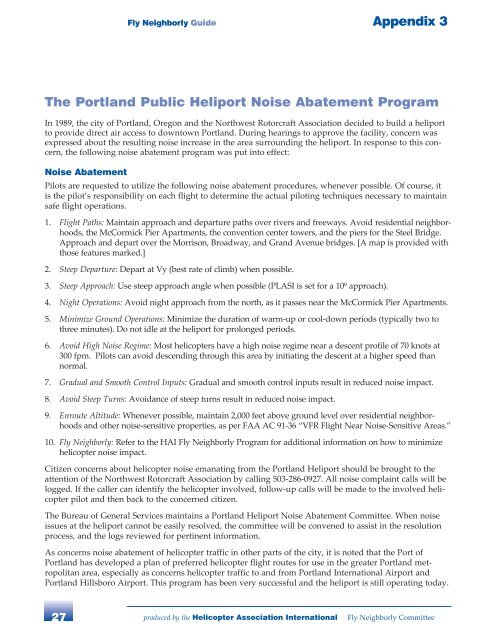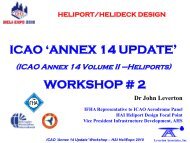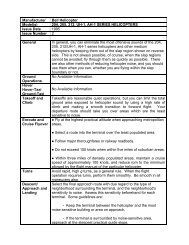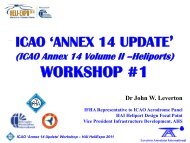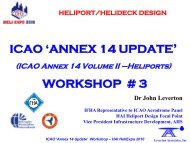<strong>Fly</strong> <strong>Neighborly</strong> <strong>Guide</strong> Appendix 2FAA Advisory Circular AC 91.36DDate: September 17, 2004 AC No: 91-36DSubject: VISUAL FLIGHT RULES (VFR) FLIGHT NEAR NOISE-SENSITIVE AREAS Initiated by: ATO-R1. PURPOSE. This Advisory Circular (AC) encourages pilots making VFR flights near noisesensitive areas to fly at altitudeshigher than the minimum permitted by regulation and on flight paths that will reduce aircraft noise in such areas.2. EFFECTIVE DATE. This advisory circular is effective on September 17, 2004.3. CANCELLATION. Advisory Circular 91-36C, Visual Flight Rules (VFR) Flight Near Noise Sensitive Areas, datedOctober 19, 1984, is cancelled.4. AUTHORITY. The FAA has authority to formulate policy regarding use of the navigable airspace (Title 49 UnitedStates Code, Section 40103).5. EXPLANATION OF CHANGES. This AC has been updated to include a definition of “noisesensitive” area and addreferences to Public Law 100-91; the FAA Noise Policy for Management of Airspace Over Federally Managed Lands,dated November 1996; and the National Parks Air Tour Management Act of 2000, with other minor wording changes.6. BACKGROUND.a. Excessive aircraft noise can result in annoyance, inconvenience, or interference with the uses and enjoyment ofproperty, and can adversely affect wildlife. It is particularly undesirable in areas where it interferes with normal activitiesassociated with the area’s use, including residential, educational, health, and religious structures and sites, and parks,recreational areas (including areas with wilderness characteristics), wildlife refuges, and cultural and historical siteswhere a quiet setting is a generally recognized feature or attribute. Moreover, the FAA recognizes that there are locationsin National Parks and other federally managed areas that have unique noise-sensitive values. The Noise Policy forManagement of Airspace Over Federally Managed Areas, issued November 8, 1996, states that it is the policy of theFAA in its management of the navigable airspace over these locations to exercise leadership in achieving an appropriatebalance between efficiency, technological practicability, and environmental concerns, while maintaining the highestlevel of safety.b. The Federal Aviation Administration (FAA) receives complaints concerning low flying aircraft over noise sensitiveareas such as National Parks, National Wildlife Refuges, Waterfowl Production Areas and Wilderness Areas. Congressaddressed aircraft flights over Grand Canyon National Park in Public Law 100-91 and commercial air tour operationsover other units of the National Park System (and tribal lands within or abutting such units) in the National Parks AirTour Management Act of 2000.c. Increased emphasis on improving the quality of the environment requires a continuing effort to provide relief and protectionfrom low flying aircraft noise.d. Potential noise impacts to noise-sensitive areas from low altitude aircraft flights can also be addressed throughapplication of the voluntary practices set forth in this AC. Adherence to these practices is a practical indication of pilotconcern for the environment, which will build support for aviation and alleviate the need for any additional statutory orregulatory actions.7. DEFINITION. For the purposes of this AC, an area is “noise-sensitive” if noise interferes with normal activities associatedwith the area’s use. Examples of noise-sensitive areas include residential, educational, health, and religiousstructures and sites, and parks, recreational areas (including areas with wilderness characteristics), wildlife refuges, andcultural and historical sites where a quiet setting is a generally recognized feature or attribute.8. VOLUNTARY PRACTICES.a. Avoidance of noise-sensitive areas, if practical, is preferable to overflight at relatively low altitudes.b. Pilots operating noise producing aircraft (fixed-wing, rotary-wing and hot air balloons) over noisesensitive areasshould make every effort to fly not less than 2,000 feet above ground level (AGL), weather permitting. For the purposeof this AC, the ground level of noise-sensitive areas is defined to include the highest terrain within 2,000 feet AGL laterallyof the route of flight, or the uppermost rim of a canyon or valley. The intent of the 2,000 feet AGL recommendationis to reduce potential interference with wildlife and complaints of noise disturbances caused by low flying aircraft overnoise-sensitive areas.c. Departure from or arrival to an airport, climb after take-off, and descent for landing should be made so as to avoidprolonged flight at low altitudes near noise-sensitive areas.d. This advisory does not apply where it would conflict with Federal Aviation Regulations, air traffic control clearances orinstructions, or where an altitude of less than 2,000 feet AGL is considered necessary by a pilot to operate safely.9. COOPERATIVE ACTIONS. Aircraft operators, aviation associations, airport managers, and others are asked to assistin voluntary compliance with this AC by publicizing it and distributing information regarding known noise-sensitive areas.Signed________________________________Sabra W. Kaulia26produced by the <strong>Helicopter</strong> <strong>Association</strong> <strong>International</strong> n <strong>Fly</strong> <strong>Neighborly</strong> Committee
<strong>Fly</strong> <strong>Neighborly</strong> <strong>Guide</strong> Appendix 3Appendix 3The Portland Public Heliport Noise Abatement ProgramIn 1989, the city of Portland, Oregon and the Northwest Rotorcraft <strong>Association</strong> decided to build a heliportto provide direct air access to downtown Portland. During hearings to approve the facility, concern wasexpressed about the resulting noise increase in the area surrounding the heliport. In response to this concern,the following noise abatement program was put into effect:Noise AbatementPilots are requested to utilize the following noise abatement procedures, whenever possible. Of course, itis the pilot’s responsibility on each flight to determine the actual piloting techniques necessary to maintainsafe flight operations.1. Flight Paths: Maintain approach and departure paths over rivers and freeways. Avoid residential neighborhoods,the McCormick Pier Apartments, the convention center towers, and the piers for the Steel Bridge.Approach and depart over the Morrison, Broadway, and Grand Avenue bridges. [A map is provided withthose features marked.]2. Steep Departure: Depart at Vy (best rate of climb) when possible.3. Steep Approach: Use steep approach angle when possible (PLASI is set for a 10º approach).4. Night Operations: Avoid night approach from the north, as it passes near the McCormick Pier Apartments.5. Minimize Ground Operations: Minimize the duration of warm-up or cool-down periods (typically two tothree minutes). Do not idle at the heliport for prolonged periods.6. Avoid High Noise Regime: Most helicopters have a high noise regime near a descent profile of 70 knots at300 fpm. Pilots can avoid descending through this area by initiating the descent at a higher speed thannormal.7. Gradual and Smooth Control Inputs: Gradual and smooth control inputs result in reduced noise impact.8. Avoid Steep Turns: Avoidance of steep turns result in reduced noise impact.9. Enroute Altitude: Whenever possible, maintain 2,000 feet above ground level over residential neighborhoodsand other noise-sensitive properties, as per FAA AC 91-36 “VFR Flight Near Noise-Sensitive Areas.”10. <strong>Fly</strong> <strong>Neighborly</strong>: Refer to the HAI <strong>Fly</strong> <strong>Neighborly</strong> Program for additional information on how to minimizehelicopter noise impact.Citizen concerns about helicopter noise emanating from the Portland Heliport should be brought to theattention of the Northwest Rotorcraft <strong>Association</strong> by calling 503-286-0927. All noise complaint calls will belogged. If the caller can identify the helicopter involved, follow-up calls will be made to the involved helicopterpilot and then back to the concerned citizen.The Bureau of General Services maintains a Portland Heliport Noise Abatement Committee. When noiseissues at the heliport cannot be easily resolved, the committee will be convened to assist in the resolutionprocess, and the logs reviewed for pertinent information.As concerns noise abatement of helicopter traffic in other parts of the city, it is noted that the Port ofPortland has developed a plan of preferred helicopter flight routes for use in the greater Portland metropolitanarea, especially as concerns helicopter traffic to and from Portland <strong>International</strong> Airport andPortland Hillsboro Airport. This program has been very successful and the heliport is still operating today.27produced by the <strong>Helicopter</strong> <strong>Association</strong> <strong>International</strong> n <strong>Fly</strong> <strong>Neighborly</strong> Committee


